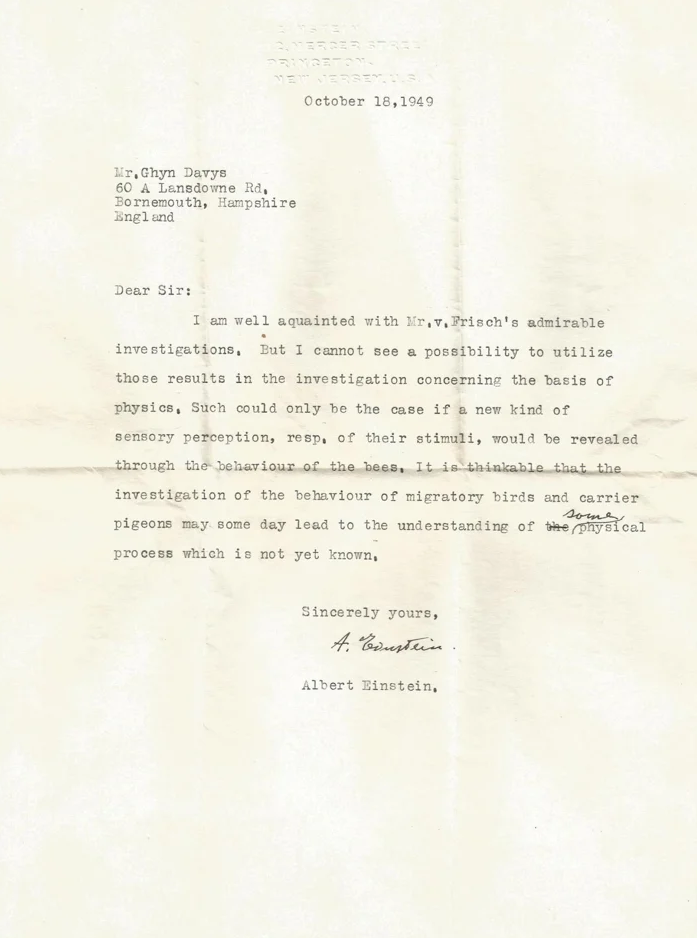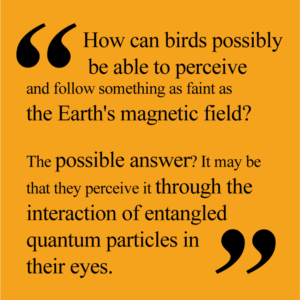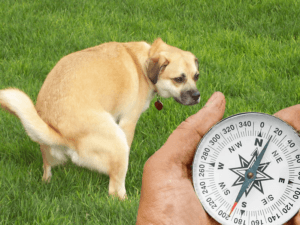
Einstein sensed that animals had super senses.
In 1949 Albert Einstein had an exchange of ideas with engineer Glyn Davys, from Hampshire, England. In a series of letters, the two discussed how various animals seem to be able to perceive things we cannot.
Mr. Davy’s original letter to Einstein is lost, but Einstein’s response letter was recently donated to The Hebrew University of Jerusalem. The letter shows that Davys was questioning animal perception regarding the physical world.
In his reply Einstein wrote:
“It is thinkable that the investigation of the behavior of migratory birds and carrier pigeons may someday lead to the understanding of some physical process which is not yet known,”

Though both Einstein, and Davys would’ve already been aware of echolocation in bats, a basis for the recent invention of radar, they were still way ahead of their time.
Since 1949 when they were wondering about it, bird and bee navigation has been widely studied. It is believed that both creatures can sense the earth’s magnetic fields. Birds sense it with a series of receptors that are mostly in its head and eyes. Bees are said to have sensors in their gut/thorax area.
In recent decades there is strong scientific evidence that suggests, marine turtles, dogs, and many mammals can all sense the planet’s magnetic fields and use them for navigation as well.
Dogs can see what we can’t
For some reason, magnetic field perception in dogs hasn’t been studied as much as in birds. Probably because birds perform such a visible and impressive migration. Dogs just have to find their way back to you, but they usually do that very well.
A team, led by zoologist Hynek Burda of Germany’s University of Duisburg-Essen, reports in Frontiers in Zoology that dogs have a sense they call “magnetoreception”. This is used to navigate the earth’s invisible magnetic field (MF). As with birds, dogs seem to sense the MF predominantly through special photoreceptors in their eyes called cryptochromes.
 It’s not known how much a dog relies on this hidden sense, or exactly how this cryptochrome-magnetoreception works, but this article describes one way that these “cryptochomes” may function. It references another Einstein theory: Quantum Entanglement and “Spooky Energy”, which are frankly over my head, but you may find interesting.
It’s not known how much a dog relies on this hidden sense, or exactly how this cryptochrome-magnetoreception works, but this article describes one way that these “cryptochomes” may function. It references another Einstein theory: Quantum Entanglement and “Spooky Energy”, which are frankly over my head, but you may find interesting.
Tracking and scouting
Maybe you’ve noticed the actions of your dog when he’s off-leash and out of sight. A lot of dogs retrace their steps as they come back to you. They’re using their sense of smell and it’s called “tracking”.
But sometimes your dog will come back to you in a way he’s never traveled before. They call this “scouting”. Studies have shown that the dog starts this process with a north/south walk or run for about 65 feet. It’s called a “compass run” and is thought to orient the dog so they can follow the magnetic fields and “scout” back to you.
A pooping polarity predisposition.
Another odd piece of information from the study was that dogs tend to poop and pee on a north/south axis.
70 dogs of different breeds were studied. It showed that, under the right conditions, dogs positioned themselves facing north or south to defecate or urinate.
The conditions vary because the magnetic fields of the earth can change due to time of day, winds, weather, and many other factors. Sometimes the MFs are weak or distorted and the dog’s positioning may not be truly north/south.
I don’t know about you, but I’m going to bring a compass on our next walk.

Research is ongoing to answer other questions like:
- How much do dogs depend on magnetoreception?
- Would feeding them on a north/south axis be beneficial?
- What other effects do magnetic storms have on dogs?
If you have a story about your dog’s sense of direction, navigation, or even polarity when going to the bathroom – please leave it below. The Jog with Your Dogs community would love to know!

